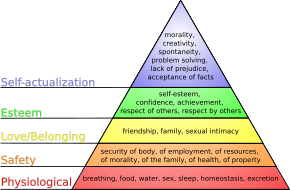Motivation and emotion/Book/2020/Eudaimonia
Overview
[edit | edit source]The question of what a "good" life consists of and how one may achieve it has almost certainly been on people's minds since human societies were first in a secure enough position to think so far ahead. It is a question that the vast majority of us consider at some point in our lives; what does "success" mean to me? What makes a good life? Am I living as fully as I could be? What can I do to ensure that I'm proud of the life I led when I'm at the end of it? There are many different philosophical schools of thought that address this concern, proposing their ideas about what constitutes a worthwhile existence. One such concept is Aristotle's eudaimonia.
|
Focus questions:
|
What is eudaimonia and why is the concept useful?
[edit | edit source]
Eudaimonia can be translated to "human flourishing" (add source), and is considered the epitome of wellness - true fulfillment.
Aristotle referred to eudaimonia as, "[the] highest of all goods achievable by human action" (Ryff & Singer, 2006, p. 14).
- Etymologyː Greek - "eu"ː good, "daimon"ː spirit (add source)
History
[edit | edit source]Aristotle, Greek philosophy (Stoicism)
Happiness and hedonism
[edit | edit source]Qualitatively different from eudaimonia (Waterman, 1993).
Define hedonism
See Figure 1.
Theoretical frameworks and approaches
[edit | edit source]There are a few major theories/approaches that apply well to the research and discussion of eudaimonia.
Self-determination theory (Ryan & Deci, 2006)
[edit | edit source]Autonomy, Competence, Relatedness
Add image
Psychological well-being model (Ryff & Singer, 2006)
[edit | edit source]Self acceptance, purpose in life, environmental mastery, positive relationships, personal growth, autonomy (Ryff & Singer, 2006, p. 20).
Add image

Maslow's hierarchy of needs
[edit | edit source]Physiological, safety, love and belonging, esteem, self-actualization.
See Figure 2.
Figures
[edit | edit source]Important points about using figures:
- Figures can be used to illustrate concepts, add interest, and provide examples.
- Figures should be captioned (using APA style) in order to explain its relevance to the text.
- Possible images for use as figures can be found at Wikimedia Commons.
- Images can also be uploaded if they have appropriate licenses for re-use or if you created the image.
- Each figure should be referred to at least once in the main text (e.g., see Figure 1).
Tables
[edit | edit source]Important points about using tables:
- Tables can be an effective way to organise content.
- Tables should be captioned (using APA style) in order to explain its relevance to the text.
- Each table should be referred to at least once in the main text (e.g., see Table 1 and Table 2).
Here are two example tables which could be adapted:
Table 1.
Example of a Table with an APA Style Caption
| Col. 1 | Col. 2 | Col. 3 |
|---|---|---|
| C1R1 | C2R1 | C3R1 |
| C1R2 | C2R2 | C3R2 |
| C1R3 | C2R3 | C3R3 |
Table 2.
Another Example of a Table with an APA Style Caption
| Col. 1 | Col. 2 | Col. 3 |
|---|---|---|
| C1R1 | C2R1 | C3R1 |
| C1R2 | C2R2 | C3R2 |
| C1R3 | C2R3 | C3R3 |
Feature boxes
[edit | edit source]Important points about using feature boxes:
- Feature boxes can be used to highlight content.
- Possible uses for feature boxes include:
- Focus questions
- Case studies or examples
- Take-home messages
- There are many different ways of creating feature boxes (e.g., see Pretty boxes)
|
Quiz questions
[edit | edit source]Important points about using quizzes:
- Quiz questions can be used to help make a chapter more interactive.
- To learn about different types of quiz questions, see Help:Quiz.
- Rather than presenting one longer quiz at the end, consider adding, say, one review quiz question per major section.
- Try to assess conceptual knowledge, rather than trivia.
Here are some simple example quiz questions:
Choose the correct answers and click "Submit":
How can eudaimonia be achieved?
[edit | edit source]- Courage, presence/mindfulness, integrity, self-trust, ambition (being virtuous, considering excess & deficiency - Aristotle and Stoics)
- Intimacy and healthy, meaningful relationships with others
- Disparity between Stoics and Aristotle about what they considered necessary vs a bonus (eg good health)
Conclusion
[edit | edit source]Important points about this section:
- This is arguably the most important section.
- What is the answer to the question in the sub-title (based on psychological theory and research)?
- What are the practical, take-home messages?
Eudaimonia is a form of well-being that emphasizes life purpose, meaning and future orientation. It shares similar - with satisfaction, happiness, flourishing, and resilience(?).
Central models and theories to it include self-determination theory, Ryff's psychological well-being model, Diener's ̈model of subjective well-being, and Seligman's concept of authentic happiness.
It can be developed through active focus on meaning (rather than outcome), engaging in experiences of flow, practicing a future orientation (rather than present or past), prosocial behaviour and community engagement.
See also
[edit | edit source]- Eudaimonia (Wikipedia)
- Flourishing (Book chapter, 2018)
- Hedonic treadmill (Book chapter, 2014)
- Meaning and happiness (Book chapter, 2017)
References
[edit | edit source]Ryff, C., & Singer, B. (2006). Know thyself and become what you are: a eudaimonic approach to psychological well-being. Journal of Happiness Studies, 9(1), 13–39. https://doi.org/10.1007/s10902-006-9019-0
Waterman, A. (1993). Two conceptions of happiness: contrasts of personal expressiveness (eudaimonia) and hedonic enjoyment. Journal of Personality and Social Psychology, 64(4), 678–691. https://doi.org/10.1037/0022-3514.64.4.678
